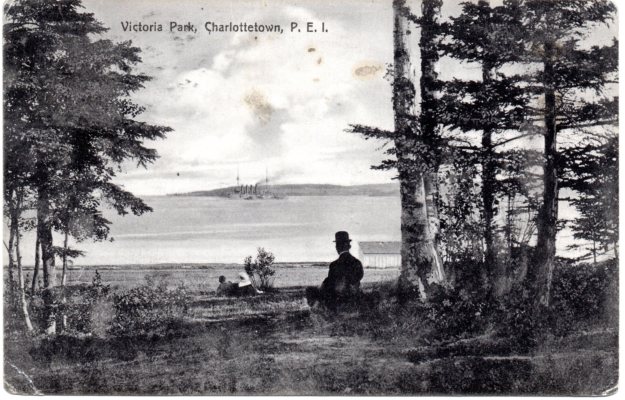
HMCS Niobe illuminated for Coronation Day 1911. Photo courtesy of Greg Gallant.
In my recent posting on the first official Canadian naval visit to Charlottetown I noted that HMCS Niobe was in the harbour for Coronation Day 1911. When I wrote that post I was surprised that there seemed to be no photos of the ship while in Charlottetown harbour as it was a major event in the harbour history.

Joseph Edward McInnis. First PEI recruit to join the crew of the Niobe. Photo courtesy of Greg Gallant.
Several readers have responded to fill the void. Greg Gallant, a collector of PEI militaria, generously loaned me two albums of material on the Niobe. He had a relative who was a member of the Niobe’s crew and who went on to other naval involvement. Greg has identified a number of other Islanders who were on the ship including the lad pictured at the right. Joseph Edward McInnis of Charlottetown was first of a number of Islanders to be taken onto the crew which numbered some 700 men. The Charlottetown Guardian noted that on the first few days the new-to-Canada warship was in port, only those with Island connections were given leave to disembark from the vessel and visit the City. After completing their training exercises with the ship’s guns later in the visit the officers allowed a more general exodus and the streets of the city were filled with Bluejackets. As well, Greg’s albums also contained the rare night photograph seen at the head of this posting of the warship outlined in electric lights as it lay in the harbour.
In an amazing coincidence a few days after posting the Niobe article I also heard from a fellow post card collector, Phil Culhane of Ottawa, who forwarded an image of a card he had recently acquired. The card carried the imprint of R.F. Maddigan, a merchant of Charlottetown who was responsible for a large number of postcards during the period.

HMCS Niobe firing Royal Salute, Charlottetown Harbour, Coronation Day 1911. Postcard image courtesy of Phil Culhane.
In its coverage of the Niobe’s visit the Guardian noted with satisfaction that although there had been requests that the ship remain in Quebec City for the celebration of Coronation Day it had been decided that Charlottetown would have the honour of hosting the vessel for the important event .

Crew of the HMCS Niobe in the Coronation Day parade, Victoria Park Roadway, Charlottetown. Photo courtesy of Greg Gallant
Coronation Day was celebrated on June 22 1911 and marked the crowning of George V and Mary of Teck as King and Queen of the United Kingdom and the British Empire. It was widely celebrated as a public holiday in British possessions and Dominions around the world. In Charlottetown there were special church services, salutes, and a parade. The ship’s company of the Niobe along with the ship’s band accompanied local military and civilian organizations and marched through the city to Victoria Park. The Guardian had warned the residents of the capital that the ship’s band was really more of a ship’s orchestra as it contained string instruments but the photo clearly shows that they were capable of providing marching music. It is not clear if the piper was part of the ship’s company or was loaned for the occasion.

Band of HMCS Niobe. Coronation Day Parade. Photo courtesy of Greg Gallant.




